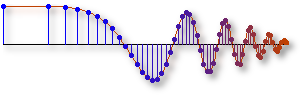7. Discrete-Time Fourier Transform
Overview: Here the discrete-time Fourier transform (DTFT) is introduced along with the inverse DTFT.
Transform pairs and properties are developed.
The transform method solves the input-output problem for a filter by exploiting the convolution property of the DTFT which converts the convolution
\(y[n]=x[n]\ast h[n]\) to a multiplication of DTFTs,
$$Y(e^{j\hat\omega})=X(e^{j\hat\omega})H(e^{j\hat\omega})$$
The frequency response is therefore understood to be the DTFT of the impulse response.
Ideal filters are presented along with the window method of FIR filter design in which the impulse response of an ideal filter is truncated and weighted with window coefficients.
Demos - MATLAB 2
A table of DTFT pairs is usually given as a list of formulas for the signal
\(x[n]\) and its DTFT \(X(e^{j \hat\omega})\). These formulas
can be visualized as plots, and this demo focuses on the ability to recognize
signals and transforms in a graphical form.
The Filter Design Demo is a program that designs simple FIR (and IIR) digital filters,
along with tutorial visualizations of the filter design process.
Features:
- FIR Design with many different window types
- Numerous plot options: magnitude/phase response, pole-zero diagram, and impulse response
- IIR Design of Butterworth filters
- Parks-McClellan FIR Design showing the iterations of the Remez Exchange method
Labs - MATLAB 2
This lab introduces a practical application where sinusoidal signals are used to transmit information: a
touch-tone dialer. Bandpass FIR filters can be used to extract the information encoded in the waveforms.
The goal of this lab is to design and implement bandpass FIR filters in M ATLAB , and to do the decoding
automatically. In the experiments of this lab, you will use
firfilt(), or conv(), to implement filters and
freqz() to obtain the filter’s frequency response. 1 As a result, you should learn how to characterize a filter
by knowing how it reacts to different frequency components in the input.
[Files]
The goal of this lab is to learn some methods for designing practical FIR filters in Matlab. These filters
will have a finite number of coefficients, and a frequency response that approximates an ideal frequency
response shape.


